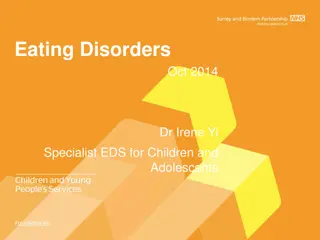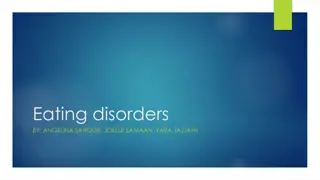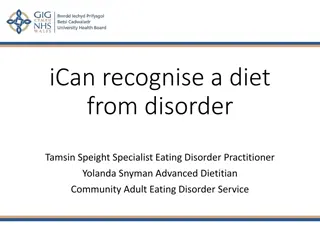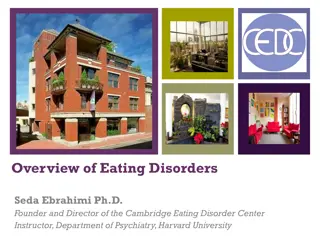Understanding Eating Disorders: Key Insights from Dr. James R. Kirkpatrick, MD
Dr. James R. Kirkpatrick, MD, a renowned expert in eating disorders, shares valuable insights in a webinar presentation. He emphasizes the importance of taking a detailed eating disorder history, provides reasons for initial interviews, and highlights motivations for engaging in eating disorders. Through his expertise, he aims to provide support, guidance, and understanding to individuals struggling with eating disorders.
Download Presentation

Please find below an Image/Link to download the presentation.
The content on the website is provided AS IS for your information and personal use only. It may not be sold, licensed, or shared on other websites without obtaining consent from the author. Download presentation by click this link. If you encounter any issues during the download, it is possible that the publisher has removed the file from their server.
E N D
Presentation Transcript
Taking A Detailed Eating Disorder History James R. Kirkpatrick, MD AED Webinar Presentation February 18, 2021 1
James R. Kirkpatrick, MD Chair of the Provincial Steering Committee on Eating Disorders British Columbia Cofounder of the BC Eating Disorders Association Clinical Assistant Professor, Department of Psychiatry, University of British Columbia Editor emeritus Eating Disorders: The Journal of Treatment and Prevention. Wiley/Routledge Member of the Academy for Eating Disorders Member of the World Health Organization s Global Clinical Practice Network Retired! 2
Disclosures Disclosures None 3
Reference source Taking A Detailed Eating Disorder History A Comprehensive Guide for Clinicians James R. Kirkpatrick Routledge, 2019 4
introduction Because there is too much to cover in one hour, I am going to be very selective in choosing topics 5
Interviewing The main reasons for the initial interview are to: 1. Assess life threatening risks, due to medical or suicidal causes. 2. Provide any reason what-so-ever for the individual to return for a second session. 6
Reasons to Return To be heard without judgment To feel supported To be offered positive and useful advise To see we are their advocate I ll be in your corner. To be provided viable options or ways out for dealing with problems or stresses To receive understanding when they have not been seen to receive it from family, friends or caregivers To see we can act as a liaison with family and caregivers To offer medical support 7
Motivations for Engaging in an Eating Disorder Although body image and weight control will likely be or has been the main driving force for the ED, there may be a multitude of other driving forces. We need to ask regarding this. Some of these driving forces or triggers are as follows: 8
Motivations for Engaging in an Eating Disorder Apps for mobile devices (Pro Ana & Pro Mia) Internet Social Media Cyberbullying Photographic Images Selfies Thinspirational Photos Old Photos Nonhuman Photographic Images 9
Motivations for Engaging in an Eating Disorder Animation Little Mermaid Dance: JSM Idols and Other People Competition: academic, sports, thinness Low Self-Esteem Superiority to Others Fit in, Conform, Belong Control Excuse to Fail or Not Try Punish Others Slow Suicide 10
Motivations for Engaging in an Eating Disorder Gender Dysphoria Negative Internal Dialogue Maintain Medical Instability Stay in Hospital Stay on Disability Insurance or SA Student Loans Fear of Losing Partner If Weight Gained To Keep the Family Together Attention Seeking: a cry for help Control Acne Lifeline 11
Motivations for Engaging in an Eating Disorder Coping With Abuse and Neglect Media Modeling or Acting Food Allergies 12
Personality Triad People Pleasing Perfectionism Hypersensitivity Our vulnerabilities are also our strengths. Try to quantify personality traits as each may be minor to major issues. Do these traits, if connected to EDB and EDA, serve other purposes as well? 13
Fundamentals A few suggestions 14
Why Take A Detailed ED History To vastly increase our knowledge of eating disorders generally and to greatly improve the chance of acquiring potentially useful information to help make better informed decisions regarding treatment options. Detailed history taking is not fishing , peeling an onion or digging deeper . It is eliciting important and relevant information previously not sought after. 15
Why TDEDHX The DSM lists just over a dozen or so EDBs. There are well over 100 EDBs possibly over 150 or even 200 most of which we have never enquired about. All scientific and clinical research into ED as well treatment models developed for those with ED have been based on an extremely limited understanding of ED. 16
Why TDEDHx ED assessments that just meet the minimal DSM diagnostic criteria acquire far less than 1% of ED and associated details for a given individual. It s not enough and has never been. Treatment options and successes will only improve with a vast increase in understanding of ED specifics and dynamics. 17
Key Interviewing Points Never assume. Always ask. Always know. One more question. Be more inclusive. 18
Never Assume. Always ask. Always Know, Even if one says that she is bulimic and binges and vomits do not assume you know for sure why she does either. Never assume! Always ask! Always know! Most of the time she will be vomiting to prevent weight gain or to lose weight. However, there could be many other reason why. 19
Never Assume. Always ask. Always Know, She may vomit: To relieve abdominal pain or bloating To punish herself for overeating To relieve stress To deal with remembrances of sexual assault To deal with guilt and shame To punish her family To display a cry for help. 20
Never Assume. Always Ask. Always Know. Because she has viral gastroenteritis, tuberculosis meningitis, a brain tumor, malignancy, or hepatitis Because of dozens of other possible reasons Oh and to control BI and weight 21
Motivation for Recovery Never say There is no point in seeking treatment if you are not motivated. or Come back when you re ready. There is no one motivation for change. There are multiple focuses for motivational change. As an example someone who vomits, over- exercises, takes laxatives, binge eats, restricts and has a goal to lose more weight she may initially say that she is not motivated to work on recovery. But if we ask Choose just one eating disorder behaviour that you could set a small goal to work on then she may say OK . Foot in door. 22
Motivation If she can t chose one for herself, I might suggest Do you think you could work on limiting taking 30 Ex-Lax a day to, let s say, 20 or 25 a day to start? . She may say she is more likely to try. Aside from setting eating disorder recovery goals, there are other focuses of change that may be worth considering. Setting a goal to decrease alcohol or drug use or attend a recovery program; see her physician or take her potassium supplements are worthy other goals. If the individual isn t ready to set even one goal, then say Fine. We ll talk about this another time. 23
Motivation It may be necessary to set these non-ED goals first before even being able to work on eating disorder behaviours or attitudes. We need to clear the deck , as it were, of imposing other concerns before we tackle the ED It is our responsibility to illustrate reasons to want to make change. Individuals will need to hear that recovery is possible. We need to help them see ways out of their difficulties and that we can help them with these. We help navigate possibilities. 24
Reasons to Return Ask their opinion: How do you want me to help you? With having previous treatment, what would you like me to do the same or not want me to do? One client said that if I ever say to her, as she had been told by another clinician, You can do it! that she would smack me. I said OK . Basically, consult with individuals how they want to be treated 25
General ED History Demographic & Contact Information Make sure to have phone numbers and addresses for: Client s cell & home phone Parents, partner, close friends Work, school Very important when acquiring critical lab values or client is acutely suicidal 26
Eating Disorder Eating Disorder Behaviors Behaviors There are over 160 eating disorder behaviors (EDB) listed in the book. There are also multiple ways of implementing some EDB such as vomiting and exercising. To be discussed under EDB Parameters There will likely be over 200 eating disorder behaviors in use around the world. I had a patient with 30 active EDBs as well as previously utilized 10 more = 40 EDB total. 29
Eating Disorder Behaviors Any EDB previously utilized but not currently in use, may be revisited again. Any EDB not previously used may be brought to use. Restricting with resulting weight loss may lead to bingeing and then vomiting. The use of EDBs may be static and predictable or may change unpredictably. Though the EDBs have been grouped into specific subcategories, some may easily belong in other categories. As an example, cigarette use is listed under Restricting Eating Behaviors. It also belongs under Calorie Burning. 30
Eating Disorder Behaviors I consider any variation in implementing a given EDB a separate EDB. As an example, the use of 2 fingers to trigger vomiting may be deemed a separate EDB from someone using 4 fingers. Why? The use of 4 fingers implies she may be losing her gag reflex and, therefore, may choose to select a more harmful or even life- threatening behavior. 31
Eating Disorder Behaviors EDB Categories: Purging Calorie Burning & Metabolism Altering Body Gauging (Weight, Size, Shape) Binge Eating & Related Behaviors Restricting Eating Behaviors False Information Organizing Symptom Management Surgery & Other Cosmetic Altering Behaviors Substance Use 32
Eating Disorder Behaviors Select Eating Disorder Behaviors Trap lines Hoarding Dumpster diving Smorgasbords / Catered events Stealing food Medication avoidance Spoiling food 33
Select EDBs Aversion behaviors clean toilet Food associations: worms Ways to look healthier Eat a portion of food in a restaurant, have the rest packed up then leave the doggy bag in the restaurant accidentally Rituals 34
Select EDBs Time Rules False Information Organizing Behaviors Symptom Management Surgery and Other Cosmetic Altering Methods 35
EDB Parameters EDB Parameters are attributes or specifics thatoffer more thorough information relating to each EDB. The EDB parameters are identified by a series of questions for each EDB. It is akin to describing a car. Describing a car as being a Mercedes, green, a sports car, LP# and has a flat tire offers more attributes with regard to identifying the vehicle than just saying it is a car. 36
EDB Parameters Within each parameter, there may be several other descriptors that provide yet further details for a given EDB. Questions within questions. It is not unreasonable to expect over 70 questions that could be asked regarding a particular EDB. The EDB Parameters are the most important sets of questions to bring relevant detail to eating disorder behaviors, attitudes and their relationship to any and all connected triggers and associated factors. (Emotions, physical symptoms, family and social dynamics as well as other complicating or supportive influences) 37
EDB Parameters Eating Disorder and Non-Eating Disorder Uses for Each Suspected EDB Because someone vomits, we can only suspect it is an EDB until verified with thorough questioning A behavior used for eating disorder purposes may also be used for non-ED purposes Laxatives may be used in an attempt to control weight and/or also to relieve constipation Lifting weights may be used to control BI but may also be needed to compete as an Olympic rower. 38
EDB Parameters Past, Recent, Present, and Future Uses of Eating Disorder Behaviors Individuals often respond to questions very literally. If you ask Do you use diet pills they may say no. If you ask Do you or have you ever used diet pills they may then say yes. If they still say no then further ask Have you ever used diet pills, even once ever? Yes could be the reply. 39
EDB Parameters How How do you make yourself vomit? How many ways do you make yourself vomit? How do you make money to purchase food? How do you exercise? How many ways do you exercise? How do you cope with stress? How much alcohol do you drink? 40
EDB Parameters What What laxatives do you use? What time(s) of the day do you binge? What foods do you binge on? What feelings do you experience when you do not exercise and why? 41
EDB Parameters Why Why do you vomit? Why do you want to lose weight? Why do you eat your own vomit? Why do you burn yourself? 42
EDB Parameters When When do you binge? When do you exercise? When do you cut yourself? When do your parents come home and disrupt your plans to binge and vomit? When do you plan to kill yourself? 43
EDB Parameters Where Where do you vomit? Do you vomit at school, work, home, in the car or on the street? Do you vomit into plastic food containers, paper bags, garbage cans or in the garden? 44
EDB Parameters Who Who did you learn about laxatives from? If you do, who do you vomit with? Who gets in the way of you being able to exercise when you want to? Who supports your recovery? 45
EDB Parameters Increasing, Decreasing, Staying the Same. Are your bingeing behaviors increasing, decreasing or staying the same? Is your drive to lose weight increasing, decreasing or staying the same? What is the range ? 46
EDB Parameters Absent or On Hold Is your use of emetics currently in use or on-hold? Are you stopping the use of laxatives for good or is it just on-hold for now? 47
EDB Parameters Changing in Kind Individuals may change the kind of EDB. Someone may use Ex-Lax instead of Correctol. Changing the kind of behavior, ED or otherwise, may lead to higher risks. Switching from fingers to emetics to V Self-harm may switch from scratching their arms to taking a lethal OD. 48
EDB Parameters Linked Many EDB may be linked Bingeing is often linked to vomiting Restricting may be linked to over- exercising EDB use may be linked to emotions such as guilt, shame, regret or elation EDB may be linked to self-harm including those with suicide risk 49
EDB Parameters Mutually Exclusive Some EDB may never be used while another is being utilized. Someone who currently uses vomiting as an EDB may never use diet pills at the same time 50























